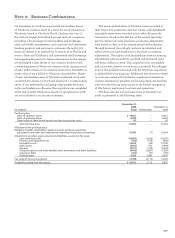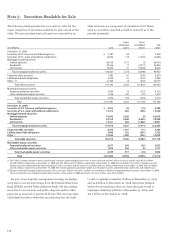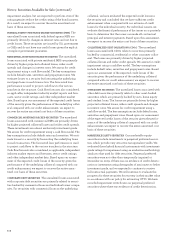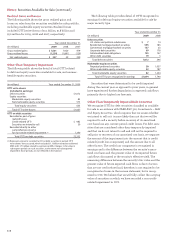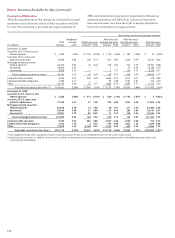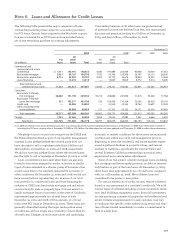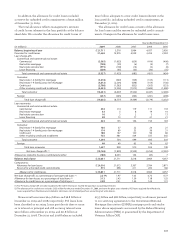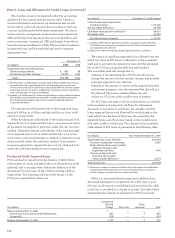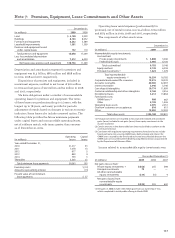Wells Fargo 2009 Annual Report Download - page 116
Download and view the complete annual report
Please find page 116 of the 2009 Wells Fargo annual report below. You can navigate through the pages in the report by either clicking on the pages listed below, or by using the keyword search tool below to find specific information within the annual report.
impairment analysis, but are expected to perform, even if the
rating agencies reduce the credit rating of the bond insurers.
As a result, we expect to recover the entire amortized cost
basis of these securities.
FEDERAL AGENCY MORTGAGE-BACKED SECURITIES (MBS) The
unrealized losses associated with federal agency MBS are
primarily driven by changes in interest rates and not due to
credit losses. These securities are issued by U.S. government
or GSEs and do not have any credit losses given the explicit
or implicit government guarantee.
RESIDENTIAL MORTGAGE-BACKED SECURITIES The unrealized
losses associated with private residential MBS are primarily
driven by higher projected collateral losses, wider credit
spreads and changes in interest rates. We assess for credit
impairment using a cash flow model. The key assumptions
include default rates, severities and prepayment rates. We
estimate losses to a security by forecasting the underlying
mortgage loans in each transaction. The forecasted loan
performance is used to project cash flows to the various
tranches in the structure. Cash flow forecasts also considered,
as applicable, independent industry analyst reports and fore-
casts, sector credit ratings, and other independent market
data. Based upon our assessment of the expected credit losses
of the security given the performance of the underlying collat-
eral compared with our credit enhancement, we expect to
recover the entire amortized cost basis of these securities.
COMMERCIAL MORTGAGE-BACKED SECURITIES The unrealized
losses associated with commercial MBS are primarily driven
by higher projected collateral losses and wider credit spreads.
These investments are almost exclusively investment grade.
We assess for credit impairment using a cash flow model. The
key assumptions include default rates and severities. We esti-
mate losses to a security by forecasting the underlying loans
in each transaction. The forecasted loan performance is used
to project cash flows to the various tranches in the structure.
Cash flow forecasts also considered, as applicable, independent
industry analyst reports and forecasts, sector credit ratings,
and other independent market data. Based upon our assess-
ment of the expected credit losses of the security given the
performance of the underlying collateral compared with our
credit enhancement, we expect to recover the entire amor-
tized cost basis of these securities.
CORPORATE DEBT SECURITIES The unrealized losses associated
with corporate debt securities are primarily related to securi-
ties backed by commercial loans and individual issuer compa-
nies. For securities with commercial loans as the underlying
collateral, we have evaluated the expected credit losses in
the security and concluded that we have sufficient credit
enhancement when compared with our estimate of credit
losses for the individual security. For individual issuers, we
evaluate the financial performance of the issuer on a quarterly
basis to determine that the issuer can make all contractual
principal and interest payments. Based upon this assessment,
we expect to recover the entire cost basis of these securities.
COLLATERALIZED DEBT OBLIGATIONS (CDOS)The unrealized
losses associated with CDOs relate to securities primarily
backed by commercial, residential or other consumer collat-
eral. The losses are primarily driven by higher projected
collateral losses and wider credit spreads. We assess for credit
impairment using a cash flow model. The key assumptions
include default rates, severities and prepayment rates. Based
upon our assessment of the expected credit losses of the
security given the performance of the underlying collateral
compared with our credit enhancement, we expect to recover
the entire amortized cost basis of these securities.
OTHER DEBT SECURITIES The unrealized losses associated with
other debt securities primarily relate to other asset-backed
securities, which are primarily backed by auto, home equity
and student loans. The losses are primarily driven by higher
projected collateral losses, wider credit spreads and changes
in interest rates. We assess for credit impairment using a
cash flow model. The key assumptions include default rates,
severities and prepayment rates. Based upon our assessment
of the expected credit losses of the security given the perfor-
mance of the underlying collateral compared with our credit
enhancement, we expect to recover the entire amortized cost
basis of these securities.
MARKETABLE EQUITY SECURITIES Our marketable equity
securities include investments in perpetual preferred securi-
ties, which provide very attractive tax-equivalent yields. We
evaluated these hybrid financial instruments with investment-
grade ratings for impairment using an evaluation methodology
similar to that used for debt securities. Perpetual preferred
securities were not other-than-temporarily impaired at
December 31, 2009, if there was no evidence of credit deterio-
ration or investment rating downgrades of any issuers to below
investment grade, and we expected to continue to receive
full contractual payments. We will continue to evaluate the
prospects for these securities for recovery in their market value
in accordance with our policy for estimating OTTI. We have
recorded impairment write-downs on perpetual preferred
securities where there was evidence of credit deterioration.
Note 5: Securities Available for Sale (continued)







